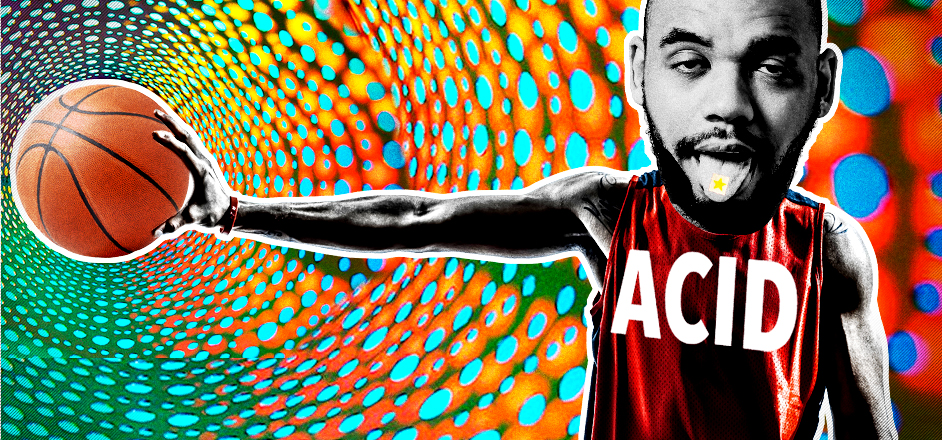Like a drop of liquid on a piece of paper, the trend of microdosing is spreading. It's seeping out of Silicon Valley tech campuses and college dorms into another aspect of life: athletics. Runners, swimmers, climbers and basketball players are reporting that they're microdosing their way to top performance.
Microdosing is when you take an amount of LSD, mushrooms or a research chemical too small to melt your consciousness or conjure giant snakes, but enough to improve your productivity, heighten creativity and make your brain work better, the way Ritalin or Prozac is supposed to but often doesn't. Because of this, it’s been called "the hot new business trip" by Rolling Stone and "the drug habit your boss is gonna love" by GQ.
Less noticed is the way microdosing is improving bodies. Athletes are saying that these highly-illegal drugs are their secret ingredient for better performance on the track, climbing routes or the yoga studio, improving concentration and endurance.
"People are talking about LSD microdosing as if it's a new health fad, like it's acai berries or goji berries," said Alex O'Bryan-Tear, scientific researcher and assistant to Amanda Feilding, the head of the Beckley Foundation, which studies psychedelic drugs.
Ask around. In the Boulder Rock Club not long ago, a world-class rock climber told me that one of his favorite things is to take LSD and climb. Helps him get into the flow. Helps quiet the mind. Helps him see the rock better. His eyes lit up as he talked about it.
At the Psychedelic Science 2017 Conference in Oakland last month, an amateur yogi told me that LSD helped him flow better. On the ground of a lecture hall, he demonstrated the ashtanga move that he said was impossible for him before he started doing yoga on acid. Somehow, the acid let him flow better.
Today's generation of drug users are often different from the ‘60s hippies; they're less likely to want to use high doses to scramble their brains, drop out or switch religions. Instead, they're looking to use smaller, smarter doses in the right situations, to live better, happier, healthier versions of the lives they're already living.
And at that same conference, a physician told me that he likes to dose small amounts of mushrooms and then go for long-distance runs. It helps quiet his mind, he said, and lets him get in the flow of the run.
Ryan Keating, a former college athlete in Salt Lake City, said that, when microdosing LSD or psilocybin and playing sports, "you are very much in the flow of your movement and feeling."
That seems to be the common denominator in the stories of microdosing and athletics: flow. Mihály Csíkszentmihályi called "flow" a state of immersion into the task at hand, when all the rest of life's ticky-tack worries — about grocery lists or annoying neighbors — drops away. Basketball and baseball players call it "the zone." Doc Ellis got there when he pitched his no-hitter on LSD.
Paul Austin, who runs the website The Third Wave and collects reports on microdosing, says athletes consistently report being in a flow state on these substances. And Jim Fadiman, the world's leading expert on microdosing, and a man who has collected more than 400 individual reports, most of them positive, said many reported "more skill in physical activities" and that "microdosing clearly increases (athletic) performance."
True believers are wildly enthusiastic. "LSD can increase your reflex time to lightning speed, improve your balance to the point of perfection, increase your concentration .. .and make you impervious to weakness or pain," extreme athlete James Oroc wrote in the bulletin for the Multidisciplinary Association for Psychedelic Studies.
So where's the downside? LSD and mushrooms can go wrong, for sure. A bad trip happens when you gobble too much and start thinking too much and get anxious and paranoid. But smaller doses don't do that. "The whole, 'It'll drive you insane,' is not on the table anymore," said O'Bryan-Tear.
O'Bryan-Tear even wonders whether LSD microdosing might one day be so prevalent that international doping bodies will want to test for these compounds. The Beckley Foundation is directing the first-ever study of LSD microdosing, and are hard at work raising money for it. They last year published the world's first images of the brain on LSD, which showed it doesn't work worse than a normal brain. (See pic below.) Instead, says O'Bryan-Tear, the images show "greater connectivity between brain regions, which could help explain how thinking styles become more fluid."
LSD, mushrooms and research chemicals might not overtake anabolic steroids as the performance-enhancing drug of the next Olympiad. But it's already made a few lives better.
.jpg)




Leave a Reply